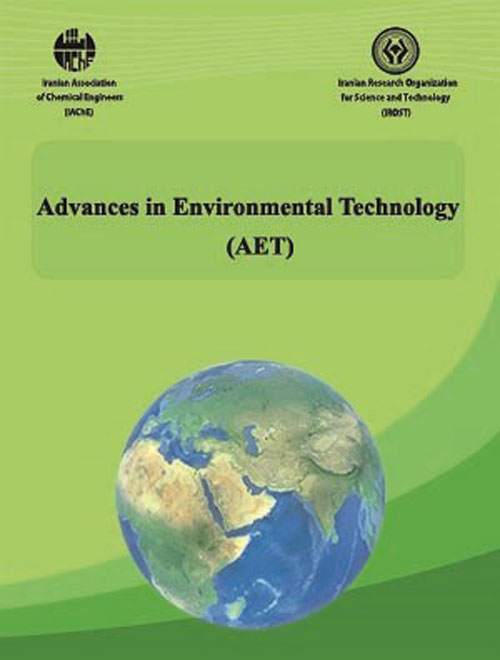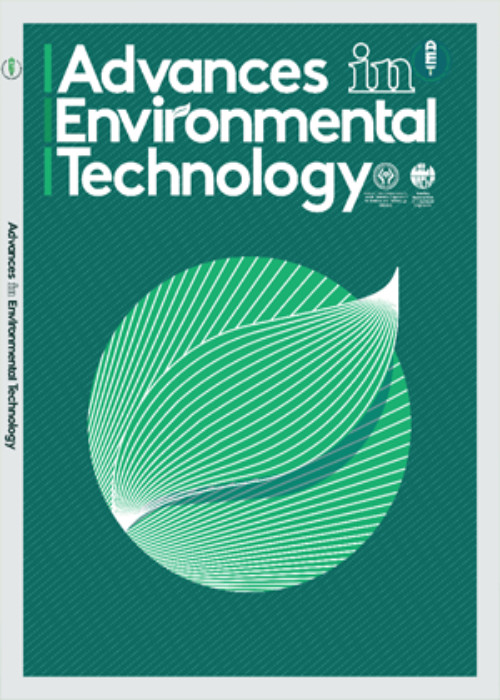فهرست مطالب

Advances in Environmental Technology
Volume:3 Issue: 2, Spring 2017
- تاریخ انتشار: 1396/02/28
- تعداد عناوین: 6
-
-
Pages 67-75The presence of arsenate in drinking water causes adverse health effects including skin lesions, diabetes, cancer, damage to the nervous system, and cardiovascular diseases. Therefore, the removal of As (V) from water is necessary. In this work, nanostructured adsorbent Fe2O3/Al2O3 was synthesized via the sol-gel method and applied to remove arsenate from polluted waters. First, the Fe2O3 load of the adsorbent was optimized. The Fe2O3/Al2O3 adsorbent was characterized by means of XRF, XRD, ASAP, and SEM techniques. The effects of the operating conditions of the batch process of As (V) adsorption such as pH, adsorbent dose, contact time, and initial concentration of As (V) solution were studied, and optimized. The thermodynamic study of the process showed that arsenate adsorption was endothermic. The kinetic model corresponded to the pseudo-second-order model. The Langmuir adsorption isotherm was better fitted to the experimental data. The Fe2O3/Al2O3 adsorbent was immobilized on leca granules and applied for As (V) adsorption. The results showed that the immobilization of Fe2O3/Al2O3 on leca particles improved the As (V) removal efficiency.Keywords: Adsorption, Arsenate, Fe2O3- Al2O3, Immobilization, Water treatment
-
Pages 77-87The sorption efficiencies of graphene oxide (GO) and functionalized multi-walled carbon nanotubes (f-MWCNTs) were investigated and elucidated to study their potential in treating acid mine drainage (AMD) containing Cu2, Mn2, Zn2, Pb2, Fe3 and Cd2 metal ions. Several layered GO nanosheets and f-MWCNTs were formed via the modified Hummers method and the acid treatment of the MWCNTs, respectively. The prepared nanoadsorbents were characterized by field emission scanning electron microscopy (FE-SEM), Fourier transformed infrared (FTIR) spectroscopy, and BET surface area analysis. The batch method was utilized to evaluate the pH effect, sorption kinetics and isotherms. The results demonstrated that the sorption capacities of the MWCNTs increased greatly after oxidation and those of the GO decreased after reduction. Hence, the sorption mechanisms seemed principally assignable to the chemical interactions between the metal ions and the surface functional groups of the adsorbents. Additionally, the adsorption isotherm results clearly depicted that the adsorption of the Cu2 ion onto the GO adsorbent surface was well fitted and found to be in good agreement with the Langmuir isotherm model as the obtained regression constant value (R2) was found to be 0.9981. All results indicated that GO was a promising material for the removal of toxic metal ions from aqueous solutions in actual pollution management.Keywords: Graphene Oxide, Multi-Walled Carbon Nanotubes, Sorption process, Acid Mine Drainage, Sungun Copper Mine
-
Pages 89-98In this research modified Kaolin by Cetyltrimethylammonium bromide is used as an adsorbent for the removal of Reactive Blue 21 from aqueous solutions. Response Surface Methodology was used to study the effect of independent variables, such as Reactive Blue 21 dye concentration (20, 40, 60, 80 and 100 mg/L), time (10, 20, 30, 40 and 50), initial pH (2, 4, 6, 8 and 10) and modified Kaolin dosage (0.05, 0.1, 0.15, 0.2 and 0.25 g/50 mL) on dye removal efficiency from aqueous solutions. At the optimum conditions, predicted removal of Reactive Blue 21 by modified Kaolin was 98.26%. The confirmatory experiment was conducted, which confirmed the results by 94.42 % dye removal. Thus, the experimental investigation and statistical approach enabled us to predict Reactive Blue 21 removal by modified Kaolin. Also, the kinetics and isotherm adsorption of Reactive Blue 21 onto modified Kaolin was obeyed pseudo-second order kinetics and Langmuir isotherm.Keywords: Isotherm, Kaoline, Reactive Blue 21, Response surface methodology
-
Pages 99-108In this research, the removal of lead from the aqueous solution was investigated using natural nontoxic zeolite (clinoptilolite) as a low-cost adsorbent in order to reduce human exposure to it. The clinoptilolite zeolite obtained from the Semnan area was characterized by X-ray diffraction pattern, FTIR spectroscopy and scanning electron microscopy (SEM). The central composite design (CCD) defined under the response surface methodology (RSM) was used for designing the experiments and analyzing the sorption of lead. Three parameters of contact time (43.07-101.93 min), initial concentration (508-3006 mg/L) and temperature (20-51˚C) were applied to optimize the removal percentage of lead by zeolite. It was found that the initial concentration is the most important parameter affecting the removal percentage of lead, followed by the temperature of process. The optimum values of initial concentration, contact time and temperature were found to be 2750 ppm, 82.87 min and 65°C for 99.81% removal of lead, respectively, with a high desirability of 0.990. The adsorption data fitted the Freundlich adsorption model better than the Langmuir model, with the maximum sorption capacity of the clinoptilolite zeolite for Pb(II) equaling 136.99 (mg/g).Keywords: Lead, Clinoptilolite, Zeolite, adsorption isotherms, Response surface methodology
-
Pages 109-117The water quality of the Karaj River was studied through collecting 2137 experimental data set gained by 20 sampling stations. The data included different parameters such as T (temperature), pH, NTU (turbidity), hardness, TDS (total dissolved solids), EC (electrical conductivity) and basic anion, cation concentrations. In this study a multi-layer perceptron artificial neural network model was designed to predict the calcium, sodium, chloride and sulfate ion concentrations of the Karaj River. 1495 data set were used for training, 321 data set were used for test and 321 data set were used for validation. The optimum model holds sigmoid tangent transfer function in the middle layer and three different forms of the training function. The root mean square error (RMSE), mean relative error (MRE) and regression coefficient (R) between experimental data and models outputs were measured for training, validation and testing data sets. The results indicate that the ANN model was successfully applied for prediction of calcium ion concentration.Keywords: Ca Concentration, Karaj River, Artificial neural network, prediction
-
Pages 119-132The use of pesticides in modern agriculture is unavoidable because they are required to control weeds. Pesticides are poisonous; hence, they are dangerous if misused. Understanding the fate of pesticides will be useful to use them safely. Therefore, contaminations of water and soil resources could be avoided. The fates of pesticides in soils are influenced by their sorption, decomposition and movement. Degradation and leaching of pesticides are control by sorption. Soil organic matter and clay content are main soil constituents that have a high capacity for sorption of pesticides. Addition of organic maters to amend the soils is a usual practice that every year has been done in a huge area of worldwide. The added organic amendments to the soils affect the fate of pesticides in soils as well. Pesticides fates in different soils are different. The addition of organic matter to soils causes different fates for pesticides as well. It is known from the studies that sorption of non-ionic pesticides by soil in aqueous system is controlled mainly by the organic matter content of the soils. Sorption of pesticides has been reported to increase by amending soils with organic matter. In general, conditions that promote microbial activity enhance the rate of pesticides degradation, and those that inhibit the growth of microorganisms reduce the rate of degradation. Amendment of soils with organic matter may modify leaching of pesticides in soil. Some studies showed that organic matter added to soils reduced pesticides in ground water. Generally, organic amendments induces the restriction of pesticides leaching in soils.Keywords: Pesticides, Organic matter, Leaching, Sorption, Degradation


